Intel Unveils Meteor Lake Architecture: Intel 4 Heralds the Disaggregated Future of Mobile CPUs
by Gavin Bonshor on September 19, 2023 11:35 AM ESTSoC Tile, Part 1: Low-Power Island E-Cores, Designed for Ultimate Efficiency
Diving a little deeper into the SoC tile within Intel's Meteor Lake architecture, Intel hasn't just opted for a minor change but has made a significant leap forward, especially regarding I/O fabric scalability. The SoC tile itself isn't built on Intel 4 like the compute tile but is made by TSMC on their N6 node. Intel has ditched the old limitations of mesh routing by implementing a Network-On-Chip (NOC) on the silicon. This isn't just about making data lanes faster; it's about outlining smarter and more power-efficient access to memory. Likely an innovation from Intel's acquisition of NetSpeed back in 2018, which specialized in NoC and Fabric IP for SoCs, Intel opting for a physical NOC allows Intel to reduce the limits on bandwidth. Using EMIB and the nature of 2D scaling, the data paths are a lot shorter, translating into less power loss, but shorter wires also help reduce overall latency penalties.
Switching gears to low-power workload efficiency, Meteor Lake incorporates E-cores directly into the SoC tile, which Intel calls Low Power Island (LP) E-cores. Think of it as Intel's way of saying, "Why use a sledgehammer when a scalpel will do?". This means that the LP E-Cores are driven purely from a power-saving perspective. Having these LP E-cores available for workloads with the aid of Intel's Thread Director means lighter threads and background tasks that don't require the grunt of the P and E-cores on the compute tile can be directed onto the lower-powered LP E-cores.
While both the E and LP E-cores are based on the same Crestmont microarchitecture, the E-cores on the compute tile are built on Intel 4, along with the P-cores. The LP E-cores are made on TSMC's N6 node, like the rest of the SoC tile. These low-power island E-cores are tuned for finer-grained voltage control through an integrated Digital Linear Voltage Regulator (DLVR), and they also have a lower voltage-to-frequency (V/F) curve than the big E-cores on the compute tile, meaning they can operate with a lower power cost, thus saving power when transitioning low-intensity workloads off of the compute tile and onto the LP E-cores.
Part of the disaggregated nature of Foveros combined with individual power management controllers (PMC) within each tile means that IP blocks can be independently powered on or off when required.
SoC Tile: Bandwidth Scalability, Can't Stop The NOC
So adding a variety of tiles requires a highly competent pathing to ensure bandwidth is adequately structured. As I/O bandwidth bottlenecking was a major concern in previous iterations, Intel aims to solve bandwidth flow restrictions with a couple of solutions.
The first is through the scalability of the I/O bandwidth, which Intel does by adding what it calls 'Scalable Fabric,' which is configured for up to 128 GB/s of bandwidth throughput. All of the I/O ordering and address translation is fed through the IOC, while Intel has implanted a Network-on-Chip (NOC) to interconnect many of the different areas of the SoC.
The Network-on-Chip or NOC is designed to be coherent, and for Meteor Lake on Intel 4, this uses unordered processing, which moves data in an unordered fashion. Connecting all the tiles together through the NOC and independently through the IOC gives plenty of bandwidth headroom for devices or agents requiring it. The NOC is directly connected to the compute and graphics tile, while other elements, including the traffic fed directly through the LP E-cores on the SoC tile, media, display, the NPU, and the imaging processing unit (IPU), all going through the NOC. In terms of the connection to the I/O tile, this is connected directly to the IO fabric and then is fed through the IOC, which then goes directly to the NOC.
The SoC tile also integrates Wi-Fi 6E and can be made to support the latest Wi-Fi 7 standard. Having a future-proof method of including Wi-Fi 7 and Bluetooth 5.4 can add the next level of wireless connectivity to Intel's mobile platform. Wi-Fi 7 offers 320 MHz of bandwidth, doubling the channel width compared to its predecessor, Wi-Fi 6. It also uses 4096-QAM (4K QAM) to enable transmission speeds capable of hitting 5.8 Gbps.
We're still waiting for clarification on what this actually means. Whether it's supportive of Wi-Fi 7 or if there's some underlying compatibility within the Wi-Fi MAC integrated into the silicon. One option could be that Intel is adding a full external controller into the silicon to get to Wi-Fi 7 instead of CNVio splitting up parts of the radio stack. We have asked Intel for more details and will update you when we have a response.
That being said, Intel discloses 'support' for Wi-Fi 7 and BT 5.4, but there's a chance Intel could differentiate which wireless MAC is implemented into different chip segments. An example would be an Intel 9 Ultra SKU, bolstered by Wi-Fi 7 support, whereas a lower-end SKU like a Core 3 might utilize Wi-Fi 6E to save on cost.
Additional features include Multi-Resource Unit (RU) Puncturing and Military-grade security with WPA3 that supports GCMP-256 encryption to ensure both speed and security when connected to a wireless network. Unique features like Multi-Link Operation (MLO) in Wi-Fi 7 are designed to reduce latency and jitter by up to 60%, making it a competent solution for various user's connectivity needs. Adding Bluetooth 5.4 further complements this by improving audio quality, and it is claimed to offer up to 50% lower power consumption for longer battery life.
Also present on the SoC tile is the display controller and the media engine from the GPU. These are always-on (or at least, mostly-on) blocks that do not need to be built on a cutting-edge process node, making them good candidates to place on the SoC tile. Meteor Lake offers support for 8K HDR and AV1 video playback and contains native HDMI 2.1 and DisplayPort 2.1 connectivity.
Finally, the SoC tile also includes other key platform components, such as PCIe lanes, which are integral for connectivity to external devices such as discrete graphics cards and the platform's I/O capabilities, such as USB 4 and 3, as well as offering a direct interconnect to a separate I/O tile with Thunderbolt 4 and additional PCIe lanes. While we've touched on wireless connectivity, the SoC tiler also includes Ethernet support, although Intel hasn't disclosed yet which PHY will be included; it is likely to be capable of 2.5 GbE at the minimum.
A Note on Meteor Lake's Security Features: New Silicon Security Engine (ISSE)
Security has also been given closer attention in Meteor Lake. The architecture introduces the Intel Silicon Security Engine (ISSE), a dedicated component focused solely on securing things at a silicon level. Various vulnerabilities have been at the forefront of media over the last few years, including Meltdown, Spectre, and Foreshadow.
With real threats around the world, securing data is ever prevalent, and CPU architects and designers not only need to consider performance and efficiency, but security and doing some architecturally is just as important as a competent software stack. The Converged Security and Manageability Engine (CSME) has also been partitioned to further enhance platform security. These features collectively work to give a wide range of on-chip and off-chip securities designed to mitigate attacks on multiple fronts.


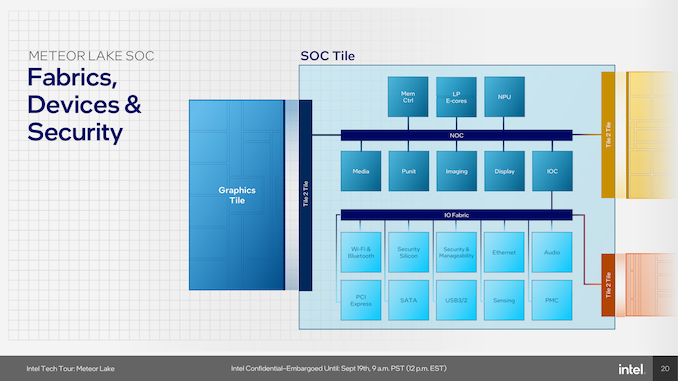
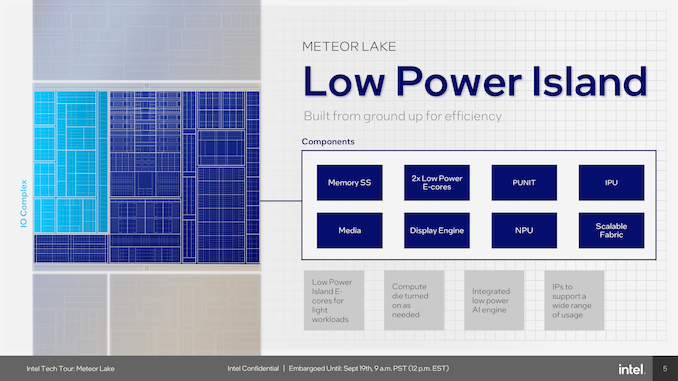
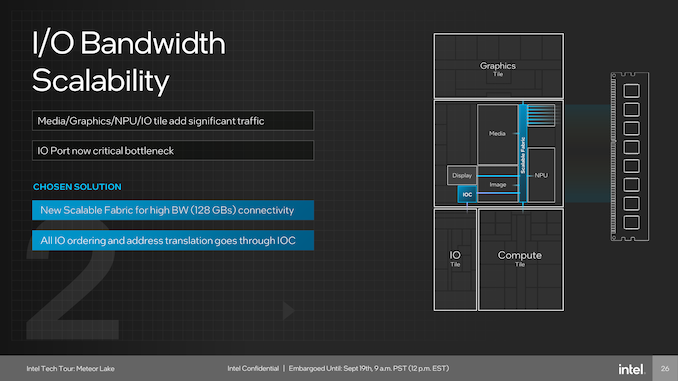
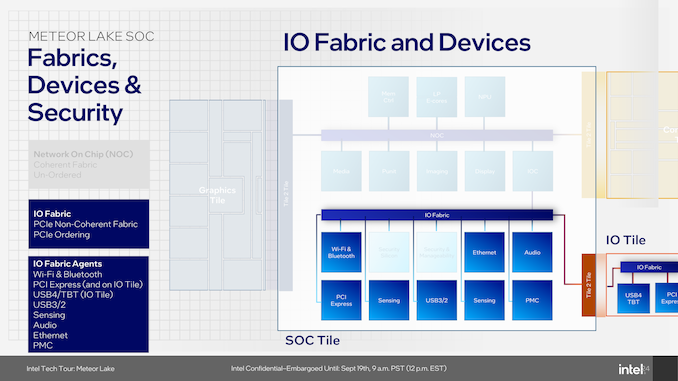
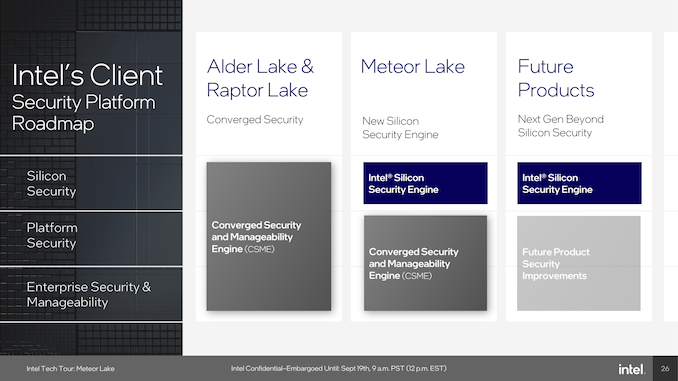








107 Comments
View All Comments
GeoffreyA - Saturday, September 23, 2023 - link
I agree with most of what you're saying. What I was trying to get at is that there seems to be a belief that Apple has superior engineering ingenuity than Intel and AMD, when really, it is the difference between fixed- and variable-length instruction sets and all that entails. What I'd like to see is all of them on the same playing field and where each then stands, from a CPU point of view. Quite likely, there won't be much of a difference because good design principles are always the same. It's trying to be out of the ordinary that leads to Pentium 4s and Bulldozers.GeoffreyA - Saturday, September 23, 2023 - link
And yes, I'd like to see RISC-V winning in the end, rather than ARM.GeoffreyA - Saturday, September 23, 2023 - link
The thing is, ARM is almost fully ready on the Windows side of the coin. Windows on ARM appears to be working well, x64 emulation is up and running, increasingly more programs are getting ARM compiles, and Microsoft's VS and compilers now have ARM on an equal footing with x64. So, if Intel or AMD decided to make an ARM CPU, people could go over quite easily, similar to the early days of x64.FWhitTrampoline - Thursday, September 21, 2023 - link
Edit: royalist/encumberments to royalty/encumberments!And Firefox's Spell Checker is so bad that The Mozilla Foundation should be stripped of their Tax Exempt status until they fully comply and fix that.
Bluetooth - Saturday, September 23, 2023 - link
Intel has proposed X86-S ISA, to get rid of all the legacy code and boot directly into 64 bit, (the proposal is available on their website). But I don't know, if this is enough to allow them to build wider decoders to improve the single thread performance.GeoffreyA - Saturday, September 23, 2023 - link
I took a look at x86-S and it certainly would be welcome, getting rid of unnecessary legacy features. From my understanding, I don't think it would help to build wider decoders. The problem in x86 is that the length of each instruction varies and is not known beforehand. At execution time, length has got to be worked out in predecode, and I imagine this constrains how much can be sent through the decoders, as well as taking up a great deal of power. In the fixed-width ISA, it is trivial to know where each instruction starts and send them off to the decoders in mass. A bit like comparing a linked list with an array.FWhitTrampoline - Tuesday, September 19, 2023 - link
up to clocked 2Ghz+ should read: Clocked up to.Bluetooth - Saturday, September 23, 2023 - link
He may overstate the power, but don't diss his remark by only focusing on that error, as the mobile processor is running at much lower frequencies.tipoo - Tuesday, September 19, 2023 - link
It sounds like you carried forward 3W from 2008. The A17 Pro draws more power than ever.https://www.youtube.com/watch?v=TX_RQpMUNx0
StevoLincolnite - Tuesday, September 19, 2023 - link
He is nothing but a liar.